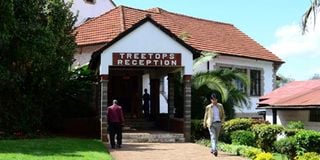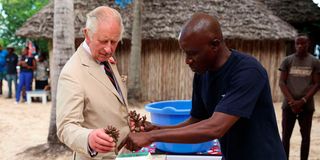
Queen Elizabeth II and Prince Philip (second left) at the site of the old Treetops Hotel in November 1983.
| FileNews
Premium
How Mau Mau erased two symbols of 1952 royal visit
What you need to know:
- The original Treetops Hotel in Nyeri, where the late Queen Elizabeth II spent her last night as princess on February 6, 1952, no longer exists.
Fact: The original Treetops Hotel in Nyeri, where the late Queen Elizabeth II spent her last night as princess on February 6, 1952, no longer exists.
Reason: It was burnt down by Mau Mau fighters on May 27, 1954. What exists is a hotel rebuilt on the opposite side of the old Mugumo (fig) tree, and which has been closed for business due to lack of customers.
The closure of Treetops indicates that the connection between sites of leisure visited by the British royal family and Kenya’s tourist industry is long broken. It is a challenge that Tourism Cabinet Secretary Alfred Mutua should take.
The ministry should urgently map these spaces and see how they can be monetised as sites of colonial memory and sites of liberation victories.
Treetops Hotel was a site of Mau Mau victory – depending on how one looks at the collapse of white hegemony in Kenya. To the Mau Mau, the burning erased part of colonial history and that of the royal family.
More so, the burning of Treetops earned Mau Mau the international coverage they were craving for. If you read travel guides, Treetops is sold as the place where Prince Elizabeth slept last before she became Queen. But for local tourism, there is little celebration of Mau Mau’s victory over that site. There is no plaque on that – which is a silence in our landscape.

Treetops Hotel in Nyeri.
It is not clear whether the Queen had been told in her November 1983 visit that the Treetops Hotel that she was visiting was on a different site from the original Treetops.
A UPI reporter noted that the Queen “had smiled her way through Kenya for four days [and] appeared to be in an angry mood at times. What the Queen saw during her 40-minute stop (at Treetops) apparently left her disappointed and a bit irritated”.
“Things are a bit different. What happened to the trees? I hardly know the place,” the Queen said. She then ignored a plaque that had been made to link her to Treetops, according to the journalist.
The original Treetops was a platform built by a colonial farmer, Captain Bill ‘Ugly’ Sheldrick, who thought that the Mugumo tree was a perfect platform for observing the animals watering in the nearby waterhole. It had opened to the public on November 6, 1932 – meaning that it would have celebrated 91 years tomorrow. As it were, the first guest was Capt Sheldrick.
The tree hotel would later be transformed into a four-roomed tree house by Sherbrooke Walker, the owner of Outspan Hotel in Nyeri. But it was more than that: For as an extension of Outspan Hotel, it had become another colonised site reserved only for the elite and a symbol of white supremacy.
More so, it had been erected on top of a tree regarded as sacred by the Kikuyu. For that, the Treetops Hotel, atop a Mugumo tree, was a sign of cultural domination. This could be the reason why the Mau Mau targeted it in the first place.
A few days before the royal couple visited Treetops, electricians had put up an artificial moon to lure the jungle beasts below the log-built hotel. It was a splendid site since the elephants, rhinoceros, and leopards usually visited the nearby natural waterhole at full moon.
The arrival of the royal family and the areas they visited was big news within the colony.

The Treetops Hotel in Nyeri.
For starters, Treetops was part of the larger modern-day Mweiga Estate, which would later be owned by Peter Marrians, who was elected Aberdares legislator in 1961.
The burning of Treetops had incensed Peter Marrian that he allowed his Mweiga Estate to be used as the operation base against Mau Mau. It was on his airstrip that the planes would land en route to Nyandarua forest to bomb Mau Mau fighters.
But despite the presence of Kenya Police Air Wing and the RAF Regiment on the farm, it was reported that the Mau Mau still managed to drive Marrian’s heifers to the forest.

King Charles III and Queen Camilla meet veteran Samwel Nthigai Mburia during a visit to the Kariokor War Cemetery in Nairobi on November 1, 2023.
Another symbol of the 1952 royal visit that was burnt by Mau Mau in 1953 was the Nyeri Polo Club, then described as one of the finest polo clubs in East Africa.
It was on these grounds that Princess Elizabeth watched her husband, Prince Philip, Duke of Edinburg, play polo on the afternoon of February 4, 1952. That date was entrenched in the royal family’s history for two days later, King George VI died, and Princess Elizabeth took over.
It is on record that as Prince Phillip chose one of the ponies from the large numbers available, famous writer Jim Colbert and his sister Margie were worried about their safety. In his book Treetops, Jim Colbert writes how he drove his car to the ravine’s edge and searched for Mau Mau footprints.
Perhaps Prince Phillip was aware of the safety measures. It was reported that during a break for drinks at the club, one of the players asked: “Can I order a drink, Sir?” And the answer was curt: “Might be better if you ordered a hearse.”
The following month, March 1953, the Mau Mau burned down the clubhouse and the stables. Though the insurance paid for the damages, since the state of emergency had not been declared, that was the end of the polo club. The Mau Mau activities slowed down the erection of a new clubhouse, and it was not until 1955 when a meeting was held to rebuild the structure with galvanised iron.

King Charles III plants young coral into an artificial reef during a visit to Kuruwitu Conservation Area in Mombasa on November 2, 2023.
By burning down the polo club, the Mau Mau were disrupting the leisure activities within the colony. By then, exclusive clubs and hotels had been turned into spaces where colonial elites exercised their imaginations of racial superiority. Polo was one of those games introduced by settler-soldiers who had served during World War I in India. The British military men are known to have started it at Calcutta Polo Club in 1862, and from there, it spread within colonial India’s elite and among the settlers and Indian nobility. It would spread into other settler colonies as one of the symbols of domination.
Again, by targeting settlers’ institution of colonial leisure, the Mau Mau were disrupting the formation of an elite British culture. This sport had consistently demonstrated status among the British (and the Indians) and the distinguishing factor of whiteness in the colony.
Polo historian Patrick McDevitt says that the game was regarded as a masculine sport and a measure of manliness. It was providing “an arena of tough masculinity”, as another writer, Tony Mason, argues in the book Sport and the Military. That was the significance of the Mau Mau raid on the Nyeri Polo Club.
The Mau Mau raid was successful because the club was never rebuilt. Though funds had been set aside, the membership started dropping, and by 1963, it was no longer viable to run a sports club that was exclusive for the white farmers.
As a result, the members called for general meeting and agreed to sell the building materials to the local settlers. They also cleared the debts, and according to the minutes of a final meeting held on November 16, 1964, the amount left was spent on a dinner at the Mount Kenya Safari Club and a dance at the Nanyuki Sports Club.
The dance marked the last time that the members would meet. Finally, the land on which the polo club stood was neglected, and on June 13, 1967, the 107 acres of Farm LR 5157/1 was taken over by the Ministry of Agriculture under the Management Order of the Agriculture Act.
The burning of Treetops Hotel and Nyeri Polo Club has been downplayed by history. It is a history that ought to be liberated.
[email protected] @johnkamau1





